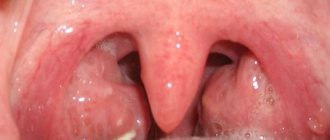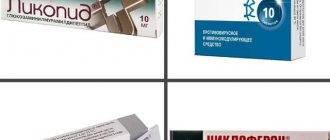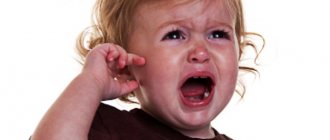Ways to treat sore throat in children
Moisturizing the mucous membrane of the throat is very important. The more it dries, the more irritation it will become. Therefore, you should often let your baby drink at room temperature. It is best if it is water or herbal tea, because sweet juices or tea with sugar make the illness worse.
If the baby is breastfed, it should be applied more often. Initially, the outgoing milk has a less dense consistency, and, in addition, antibodies and immunity-enhancing substances act as medicine.
It is also important to take care of the correct temperature and air humidification in the apartment. When it gets too hot, we not only feel unwell, but our mucous membranes dry out. The pain in the throat becomes even worse. Therefore, it is better that the thermometer in the rooms does not rise above 20°C (it can be even colder in the bedroom). A child who usually moves a lot will not freeze. However, if his neck gets cold, instead of turning on the radiators, it is better to wear an extra layer of clothing.
Relief from a sore throat can be brought by inhaling saline, which will moisturize the mucous membrane of the respiratory tract.
When to see a doctor
- Sore throat lasts longer than 48 hours.
- The child is apathetic and sleepy.
- A rash appears on the body.
- Breathing difficulties appear.
- Fever persists for more than 3 days.
To relieve a sore throat, our grandmothers gargled it with beetroot juice mixed with a spoonful of vinegar.
Physiological feature of sore throat
Adenovirus leads to significant inflammation
The virus attacks healthy cells and inflammation occurs, which is felt as pain. However, the body acts quickly: the nervous system sends impulses and ordinary inflammation turns into pain, so that a person can react and quickly eradicate the cause.
Inflammation promotes rapid blood circulation, so when you have a sore throat, you feel a rush and burning sensation. Liquid, which under strong pressure comes out of the vessels into the tissue, forms edema.
The entire immune system mobilizes all its forces to eliminate infected cells and create new ones. Adults can clearly identify the type of pain and act immediately; moreover, an adult’s immunity is more stable than a child’s.
The cause of a sore throat in a child can be identified by external signs: the condition of the throat, the presence of elevated temperature, external irritants.
Causes of sore throat:
- Viral pharyngitis is an inflammation of the posterior wall, which is accompanied by dryness and fever.
- Acute tracheitis is swelling and dry cough, which causes a sore throat.
- Acute laryngitis is an inflammation of the larynx associated with an infection that has penetrated the body.
- Sore throat and chronic tonsillitis are acute lesions of the tonsils.
- Inflammation of the lymph nodes associated with hypothermia or tension of the vocal cords.
- Infectious diseases: influenza, ARVI.
- Adenoids - enlargement of the tonsils, which causes an inflammatory process. With adenoids, the child often has his mouth open and can get a cold in the throat in bad weather.
- Sinusitis is an inflammation of the nasal mucosa that blocks the path to normal breathing and transfers all bacteria from the nasopharynx to the pharynx.
- Epiglottitis is an inflammation of the epiglottis, which complicates the airway.
- Scarlet fever - inflammation of the tonsils, rash on the body and in the throat, the presence of plaque.
- Diphtheria - infection of the pharynx.
- Measles.
- Rubella.
Non-infectious causes:
- Loads on the vocal cords.
- Penetration of foreign objects into the pharynx.
- Throat injuries - mechanical damage.
- Burn.
- Irritation associated with dust and lint getting into the throat.
- Allergic components.
- Problems with the gastrointestinal tract.
- Vitamin deficiency.
- Problems with the spine.
What causes a sore throat in a child?
Viruses, bacteria and fungi are most often to blame for a sore throat. In each of these cases, the cause-and-effect therapy is slightly different.
Infection of a viral etiology requires only relief of symptoms, and a bacterial infection requires the administration of antibiotics. Fungal pharyngitis is treated with antifungal agents.
In any situation, however, you need a pain reliever and cleanser. In the case of very young children, due to the risk of aspiration, lozenges and rinses cannot be used. However, you can use a throat spray .
A properly selected spray will act in an anti-inflammatory, analgesic and antiseptic manner. The best option is a bottle with a long applicator that allows you to spray the medication at the back of your throat.
During illness, you should not force your child to eat, and you should make sure that the food is not spicy, greasy, or requires biting. Gentle soups such as broth will be best.
Only 15-30 percent. Inflammation of the throat and tonsils in children is caused by bacteria.
Medicines for treating throat
The following medications are used to treat the throat:
- Agisept lozenges. Can be given to children from 5 years old. Makes breathing easier and soothes inflammation in the throat.
- Anti Angin in lozenges and tablets. It is also recommended for children over 5 years of age. Cope with cough and reduce pain attacks.
- Hexoral. The tablets are suitable for children aged 6 years and older.
- Grammidin in tablet form. Prescribed to children from 4 years of age.
- Imudon tablets. From 3 years of age you can take this dosage form without fear of side effects.
- Laripront. The tablet form of the drug is recommended for use from the age of 3 years. Perfectly relieves swelling of the throat and fights inflammation.
- Septolete. Lozenges are starting to be prescribed to 4-year-old children.
- Strepsils tablets are given from 6 years of age. They dissolve well and eliminate soreness.
- Tantum verde. From the age of 3, the medicine is prescribed to those children who show the first signs of a viral infection.
- Falimint in the form of tablets is prescribed to children from 5 years of age.
- Faringosept is recommended for use from the age of 3 on children with influenza or acute respiratory viral infection.
We recommend: The child cannot cough up phlegm, what should I do?
How to take care of your child's health in cold weather
Don't overheat!
This is a basic principle, but most often we forget about it. We dress our children warmer and thereby expose them to overheating. Result? The child sweats, and when the cold wind blows, he quickly catches a cold. It is recommended that children in a stroller only wear one more layer of clothing than an adult. Older children, especially if they run, should be dressed in several thin layers so that excess sweater can be quickly removed if necessary.
Take care of your diet!
Most vitamins and minerals are supplied with the diet. The most valuable ingredients are found in fruits and vegetables, so it is recommended that they appear in our diet every day. In autumn and winter, it is good to give your child sauerkraut, as well as parsley and red pepper, since they contain a lot of vitamin C. Breakfast is also important, which should become a source of energy.
Take a walk!
Many of us don't enjoy going outside in the fall and winter, which results in our children spending less time outdoors. In this way, we not only limit the fun and physical activity that they need, but also discourage their hardening. And this is what teaches the body to cope with low temperatures.
Catch the sun!
Autumn and winter in Russia are often gray and rainy, so many of us suffer from a lack of vitamin D. It is formed on the skin under the influence of sunlight. However, the weather may surprise us. There are days, although cold, when the sun breaks through the clouds. And then it’s worth taking a walk or riding a bike. If this is not possible during the week because you are at work and at daycare, catch up on the weekend.
Take care of the details!
Wind, especially cold wind, is very irritating to the skin. So it is better not to leave home without applying the appropriate moisturizer. A comfortable wardrobe is also very important. Shoes that are too small or too large are not only uncomfortable, but also expose the child to swelling, which makes it easier for him to get cold. Tight pants or tight-fitting socks are also not a good idea.
Leave the infection at home
When we are cold, have a cough and are tired from a runny nose, we would rather stay in bed. And we must do this, because otherwise we can not only get complications, but also infect others. It's the same with our children. When something hurts, they feel lethargic or have a fever, they will not enjoy their time in kindergarten.
Sore throat and antibiotics
Many caring parents, wanting to help their children, give antibiotics on the 4th–5th day of illness, if there are no visible changes.
Therefore, there is a misconception that antibiotics cure all diseases, especially those that last a long time.
However, such medications have an antibacterial effect, that is, they fight bacteria. And if viruses are present in the body, then any antibiotic is powerless.
Therefore, first of all, it is necessary to find out the source of the disease in the child, and treat accordingly.
Read: Abdominal pain in newborns
Types of antibiotics for treating throat
When treating a sore throat that is affected by a bacterial infection, several types of antibiotics are usually prescribed:
- Cephalosporins – have an inhibitory effect, stop the development of microorganisms.
- Penicillins are a disinfectant and bactericide.
- Fluoroquinalone is a group of antibiotics for restoring the respiratory tract.
- Macrolides help to get to the heart of the problem and eradicate all the potential for new bacteria.
Such antibiotics are available in tablets or small granules, which makes them convenient for use by children.
Rules for taking antibiotics for a sore throat
First of all, all antibiotic use must be agreed upon with a pediatrician. The first dose of medication is very important: it helps to determine the presence of adverse or allergic reactions in the body and will show its strength.
Secondly, it is necessary to follow all dosage recommendations and proportions. Exclude dairy products from the child’s diet for the time being and take medications with bacterial additives.
Such drugs help restore balance in the intestines and prevent the development of thrush.
What to do if your child has a sore throat?
As a rule, painful sensations in the throat in children allow you to wait for an appointment with a doctor or local pediatrician at home, but there are cases when urgent medical intervention is required.
When is it necessary to contact an ambulance?
- The child is unable to swallow saliva. Saliva flows from the mouth.
- His body temperature rose above 38 C°.
- A sick child's tonsils have suddenly enlarged.
- He's choking.
- The baby's breathing is accompanied by a whistle or squeak.
- The baby has a severe headache and nausea.
In other cases, a child’s sore throat should prompt parents to make a visit, first of all, to the doctor, and not to the nearest pharmacy.
Only after consulting with a specialist, finding out the exact disease and with a prescription in hand, can you go for medications prescribed according to the diagnosis.










